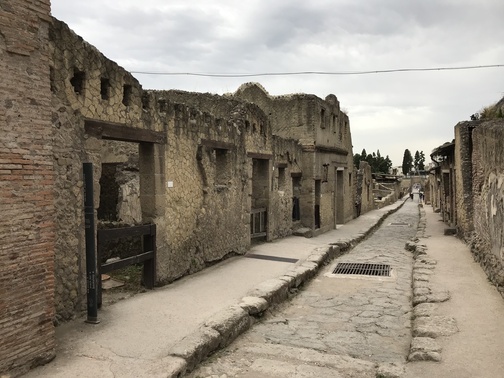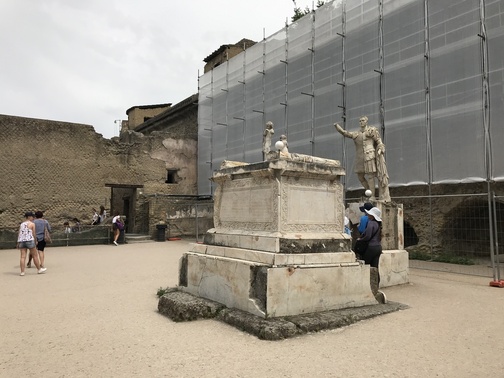Herculaneum is often considered as the younger sister of the much more famous and nearby city of Pompeii.
Yet, despite the fame and incomparable beauty of Pompeii, those who pass here cannot miss a visit to the equally beautiful Herculaneum.

View of Herculaneum
What makes Herculaneum unique is its exceptional state of conservation, in some ways even better than the excavations of Pompeii themselves, an aspect that immediately emerges due to the large presence of buildings with several floors and in many cases with roof and internal stairways, the architectural that are notoriously the most fragile compared to the inexorable passage of the centuries.
I do not dwell too much on the description of the archaeological site, although some minimal information, for those interested, is available here below.
In any case, the official website of the site, available here, has all the information regarding opening hours, ticket prices, reservations, etc.

House of the Inn
Due to its large size it is identified with a inn with the presence of a spa sector decorated with frescoes and mosaic floors. It is the largest house in the entire archaeological site.

Streets of Herculaneum

College of the Augustales
The Augustals were those who dedicated themselves to the cult of Augustus in specific colleges where the political, cultural and religious life of the city took place. It is a quadrangular building with walls articulated with blind arches. In line with the entrance a cell has been created (in the photo) with a marble floor and base, still partially preserved, with frescoes dating back to the 1st century. A.D.

Bottega ad Cucumas
The photo shows the detail of a column placed at the entrance of an inn that represents 4 jugs (the cucumae) of different colors, with the drinks that were sold here and the indication of the price of the wine. In fact, in Roman cities it was usual to have lunch outside the home.

House of the Black Hall
It is one of the most luxurious houses in Herculaneum with crock floors, mosaics and marble elements. The outdoor garden has columns with pictorial decorations with a small marble column just over 60 cm high in the center.

Streets of Herculaneum

Streets of Herculaneum

Neptune and Amphitrite House
The name of this residence derives from the wall mosaic depicting Neptune and Amphitrite while the northern part is occupied by a nymphaeum (both in the photo). It is a house that pays particular attention to the rich decoration of the triclinium (that is, of the dining room).

Grocery shop
It is a grocery shop attached to the Neptune and Amphitrite House , complete with wooden furniture consisting of shelves and a mezzanine with the presence of wine amphorae.

Termal Baths

Tepidarium
It is the male section of the Tepidarium present in the Baths and is characterized by the presence of a beautiful mosaic depicting a newt holding a rudder and a basket of fruit, surrounded by four dolphins.

Deers House

Statue of Marcus Nonius Balbus

Relief Telephus House
It is so named for the presence of a high relief depicting the myth of Telephus, a character from Greek mythology. It is characterized by its Hellenistic appearance with a colonnade made of bricks covered in red stucco used to support the upper floor. The walls are of a characteristic yellow color even if the gases developed during the eruption of Vesuvius have made them a bright red color.

